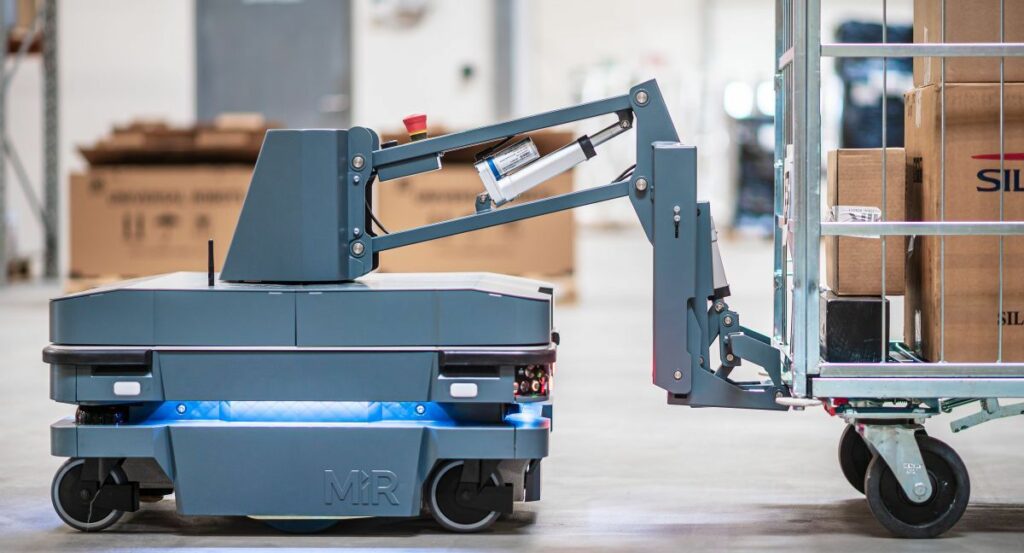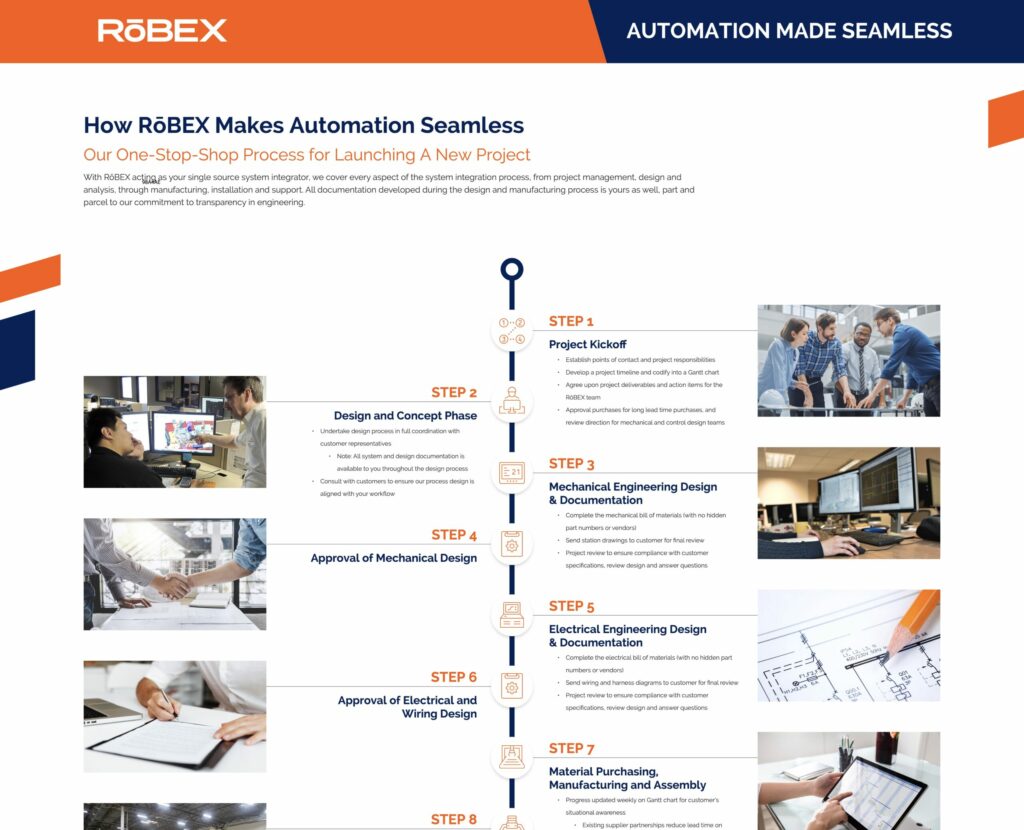Boost Productivity in Your Facility With the 5S System and AMRs
The 5S system is a well-known and widely-used organizational methodology in manufacturing. It helps promote efficiency while improving safety and organization. As companies embrace smarter technology, the 5S system can be used in conjunction with autonomous mobile robots (AMRs) to further boost productivity.
Here, we explore the 5S system in manufacturing, how it can be implemented, and how it can be used alongside AMRs to improve productivity and enhance efficiency.
What Is the 5S System?
There are five steps in the 5S system for improving productivity in manufacturing. They are:
 1. Sort
1. Sort
The first step of the 5S program in manufacturing is Sort, which is all about removing unnecessary items from the workplace. This step is important because it declutters the work area and frees up space for useful items. Even small items such as paper, boxes, or tools can accumulate and take up valuable space in a manufacturing setup.
During the Sort step, employees are encouraged to assess the items they use and categorize them based on their utility. Items that aren’t needed or rarely used are discarded, while necessary items are arranged to be easily accessible.
The Sort step lays the foundation for more organized and efficient work processes in lean manufacturing. But how can AMRs help in this step?
AMRs can make the process of removing unnecessary items from the workplace simpler. These robots use sensors to collect data about the environment and identify items that are not needed, reducing the time and effort required from employees.
Once identified, the AMRs can transport the items to a designated location for disposal or recycling. By automating this aspect of the Sort step, AMRs help free up valuable employee time, increase efficiency, and optimize the manufacturing process.
 2. Set in Order (Straighten)
2. Set in Order (Straighten)
The second step in the 5S program is Set in Order, which is also known as Straighten. This step is about organizing the necessary items in a manufacturing environment. The goal is to reduce the time and effort it takes to find the right tool, equipment, or material needed to carry out a specific task.
During the Set in Order step, employees establish a logical flow within the workspace, grouping items needed for certain tasks and ensuring they are always in the same location. This makes it easy for workers to locate necessary items quickly and also identify when an item is missing.
The Set in Order step is beneficial in streamlining manufacturing processes, reducing clutter, and optimizing workflow. When used with AMRs, the second step of the 5S system in manufacturing can be even more efficient.
These robots can transport items to designated areas, including specific storage locations, workstations, or assembly lines. This eliminates the need for employees to move items manually, reducing labor costs and the risk of injury.
By automating the Set in Order step, AMRs help maintain a structured, organized, efficient, and safer workplace for lean manufacturing, enabling employees to work more effectively and productively. AMRs can also help to monitor inventory levels and restock necessary items when levels get low, ensuring efficient operations and minimizing downtime.
3. Shine
 The third step in 5S methodology is Shine, which is all about cleanliness. This step ensures that the workplace is kept clean. It involves a thorough cleaning of machines, equipment, and workspaces to eliminate dirt and grime.
The third step in 5S methodology is Shine, which is all about cleanliness. This step ensures that the workplace is kept clean. It involves a thorough cleaning of machines, equipment, and workspaces to eliminate dirt and grime.
Shine also includes routine maintenance of tools and machinery to prevent unexpected downtime and extend their lifespan. This step not only promotes a safer work environment but also enhances the overall appearance of the workplace.
Regular cleaning also provides an opportunity for employees to spot potential safety hazards such as cracks, leaks, or frayed wires. Regular inspections and maintenance contribute to the longevity and reliability of machines and equipment, which is vital for efficient manufacturing processes.
AMRs can enhance this step as well. When equipped with cleaning tools, such as brushes or vacuums, they can move through the workspace and clean floors, walls, and other surfaces, minimizing the need for manual labor by employees. This not only saves time but also ensures thorough cleaning, leading to a safer and healthier work environment.
AMRs can also perform other maintenance tasks such as checking machines for wear and tear or monitoring machine metrics, making the Shine step an important aspect of predictive maintenance and to improve productivity in manufacturing.
4. Standardize
The fourth step to the 5S approach is Standardize, which involves creating a set of guidelines and procedures to ensure that the workplace remains organized, clean, and efficient. This step involves documenting the results of the first three steps and developing a plan to maintain the improvements made.
During the Standardize step, employees are trained on the new processes and procedures, and everyone is expected to follow these guidelines consistently. The goal is to standardize proper practices and make them a part of the workplace culture.
By making these changes part of standard operating procedures, problems such as delays or downtime become less frequent, and workplace efficiency is improved.
The Standardize step promotes consistency, reliability, and a proactive approach to manufacturing, leading to fewer errors and higher quality output.
AMRs can be enlisted to help implement and maintain the guidelines and procedures developed in the previous steps. These robots can be programmed to follow specific processes, ensuring consistency and standardization across the manufacturing environment.
For example, AMRs can be used to transport materials or products between different workstations or assembly lines at specific times, optimizing workflow and minimizing the risk of errors or delays. AMRs can even help monitor and identify deviations from standard procedures, issuing alerts or notifications when necessary.
5. Sustain
The fifth and final step to implementing 5S in manufacturing is Sustain, which involves maintaining the improvements made through the first four steps.
The Sustain step focuses on creating a culture of continuous improvement, where employees are encouraged to identify problems and implement solutions on an ongoing basis. The system implemented in the previous four steps must be regularly reviewed and updated to maintain its effectiveness.
To ensure continuous improvement, cross-functional teams may be utilized to address issues that require input from different departments. Regular audits are also conducted to ensure compliance with the 5S process. The Sustain step emphasizes the importance of continuing improvements, even after the initial improvements have been made.
AMRs can continue to help maintain the 5S principles, collecting data, analyzing processes, and identifying opportunities for improvement or areas that need attention. By doing a systematic check of the workspace environment, they can detect issues such as misplaced items or anomalies in inventory levels. These can be reported to the necessary personnel to take corrective action.
By using AMRs, companies can streamline the Sustain step of the 5S system in manufacturing and ensure that improvements made earlier are maintained and continuously improved upon moving forward.
Download Your Free Infographic

Want to understand more about how RōBEX works to create a seamless automation process so you can further improve productivity in manufacturing with 5S methodology? Download your free infographic about developing an automation system with RōBEX from the start of our process, all the way to getting your machinery up and running and continued support and maintenance.
 1. Sort
1. Sort 2. Set in Order (Straighten)
2. Set in Order (Straighten) The third step in 5S methodology is Shine, which is all about cleanliness. This step ensures that the workplace is kept clean. It involves a thorough cleaning of machines, equipment, and workspaces to eliminate dirt and grime.
The third step in 5S methodology is Shine, which is all about cleanliness. This step ensures that the workplace is kept clean. It involves a thorough cleaning of machines, equipment, and workspaces to eliminate dirt and grime.